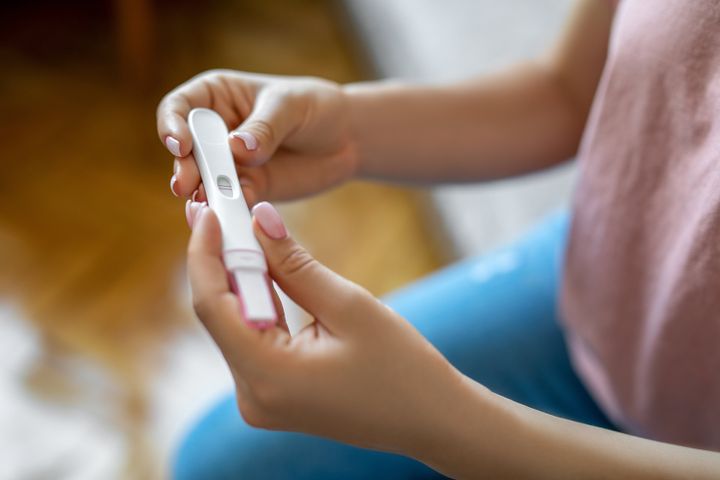
Pregnancy symptoms can be confusing, especially when they coincide with when your period is due. The body aches, fatigue, upset tummy — sometimes it’s hard to tell whether you’re just about to start your period or...you’re pregnant.
But there are some signs that are unique to early pregnancy, such as nausea and vomiting. Alongside this, changes in your vaginal discharge can also be an indicator.
Vaginal discharge changes throughout your menstruation cycle and can often show you where you are at in your cycle. It can also be a telltale sign that you’re pregnant.
What is vaginal discharge?
Dr Sarah Bonza, at Bonza Health explained that normal discharge is composed of fluid and cellular materials that are shed from a woman’s vagina.
She said: “It’s a normal occurrence and it’s what you would call a form of “housekeeping”. Having vaginal discharge is a sign that the body is keeping the vagina clean and keeping the body protected from vaginal infections. Now, no vaginal discharge is the same. It’s influenced by one’s menstrual cycle, sexual activity, hormone changes, and general health status.”
Typically vaginal discharge you have a range of clear to fluid-like to sticky, to milky white, and even “egg-white like consistency.
She explained that you often notice that when you have that “egg white like discharge” that’s clear and somewhat stretchy, you’d most likely be a few days close to your ovulation and approaching your ovulation period.
“It’s what you’d call “spinnbarkeit”. When you have that creamy milky white discharge, you might be non-fertile already as its consistency restricts movement of sperm,” Dr Sarah shares.
How is pregnancy vaginal discharge different?
When you’re pregnant, you undergo a lot of hormonal changes, this means a particular surge in progesterone and oestrogen, explains Dr Sarah.
“Usually, you’d have what we call as leukorrhea, which is white, thin, and clear discharge with only mild odour. You can notice this to be most heavy when you’re reaching the term of your pregnancy.
“I guess the range of vaginal discharge in pregnancy is the same when you’re not pregnant but with the exception of the fact that, if you’re pregnant and your leukorrhea is increasing in amount to the point that it’s leaking, or becoming thick, or jelly-like in consistency, you should go see a doctor as it may be a sign that you are in preterm labour.”
According to the NHS, having more discharge in pregnancy is normal as this helps prevent any infections travelling up from the vagina to the womb.
Dr Sarah recommends to keep an eye on the colour — if your vaginal discharge is brown, it may be a symptom of early pregnancy. Though she says it shouldn’t really be a cause of concern as sometimes it can be just old blood being passed out.
However, if you’re later on in your pregnancy and you pass this kind of discharge, see your doctor right away, says Dr Sarah.
It’s also important to note if you have light pink spotting or pinkish discharge, you might be in the early stages of pregnancy. If you’re pregnant already, it may be a sign that your body is preparing for labor, Dr Sarah advises to see a doctor right away as it may also usually happen before an ectopic pregnancy or miscarriage.
To conclude, if you have an increase in leukorrhea or your discharge is slightly brown, you might want to take a pregnancy test!
What different colours of vaginal discharge mean
It’s important to understand the red flags when it comes to vaginal discharge. Dr Sarah says you should take note not only of the colour, but also the symptoms that accompany them.
Off-white and cheese like
If your vaginal discharge seems to by off-white and cheese-like in consistency accompanied with severe itching, burning feeling while peeing or during sex, you might have a yeast infection that must be checked out.
White-gray or grayish, foul fish-like odour
If your vaginal discharge is white-gray or grayish in colour and has a foul fish-like odour, you might have bacterial vaginosis. You’ll notice that the odour becomes stronger when you don’t take a bath, practice vulvar hygiene, wiping after you pee, or after sexual intercourse.
Green or yellowish
If your vaginal discharge is green or yellowish, you might have either chlamydia or trichomoniasis. These are usually accompanied by lower abdominal pain, genital irritation and redness, and burning sensation while passing urine or during sexual intercourse.
Bright red
If your vaginal discharge is bright red, you might be on your period. However, if you’re not on your period, you might have something more concerning such as vaginal trauma, miscarriage, or ectopic pregnancy. If you have red vaginal discharge and you have heavy bleeding, with clots, and with severe cramping, and abdominal pain, especially below the umbilicus, see a doctor right away so you can be checked out.